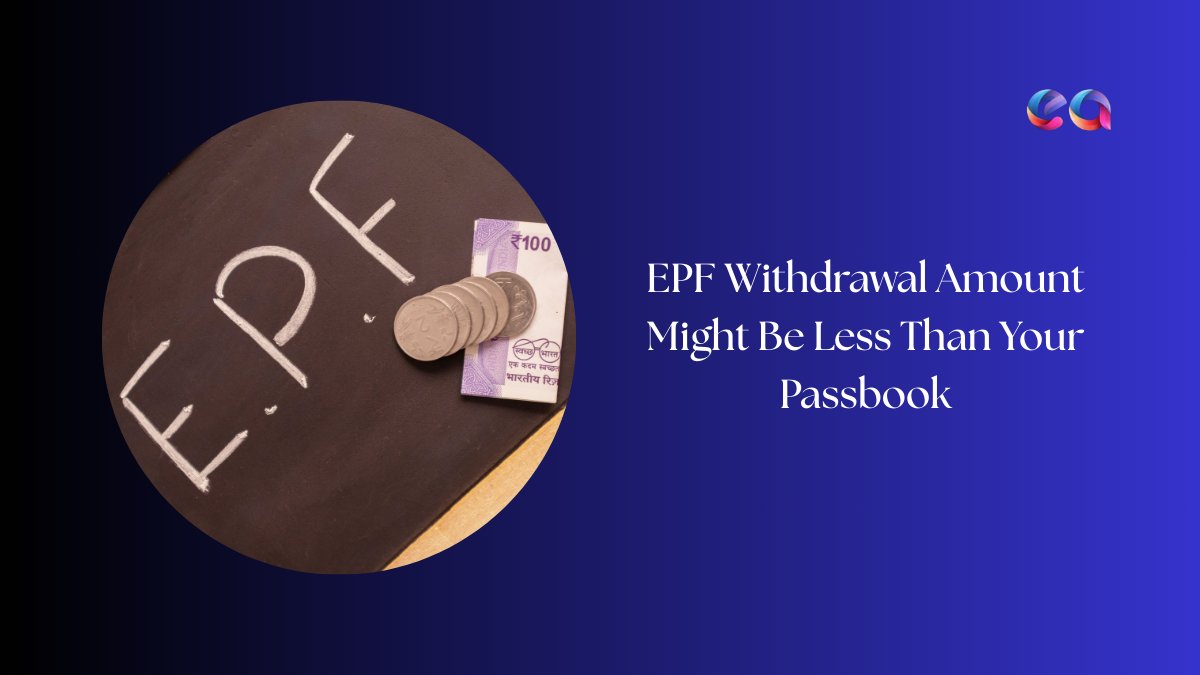
Many salaried employees in India diligently track their Employees’ Provident Fund (EPF) balance, viewing it as a crucial part of their long-term savings. The EPF passbook, easily accessible online, shows a growing balance, often leading to expectations about the amount available upon withdrawal. However, a common point of confusion and sometimes disappointment arises when an EPF member applies for a withdrawal – whether a partial advance during service or a final settlement upon leaving a job – and finds the amount credited to their bank account is noticeably less than the total balance reflected in their passbook just moments before. This discrepancy often raises questions: Was there an error? Is money missing?
The Employees’ Provident Fund (EPF) scheme, managed by the Employees’ Provident Fund Organisation (EPFO), is a cornerstone retirement savings vehicle for the Indian workforce. Established under the Employees’ Provident Funds & Miscellaneous Provisions Act, 1952, its primary objectives are to promote financial security for employees post-retirement through accumulated savings and interest, and also to provide financial support during certain life events or emergencies.
Why does the EPF withdrawal amount sometimes fall short of the passbook total? It will delve into the structure of the EPF scheme, explain the different components that make up the passbook balance, and critically analyze the specific rules and factors that lead to this difference. Understanding these elements is crucial for managing expectations and making informed financial decisions regarding EPF funds. We will explore the distinct nature of the pension contribution, the intricacies of interest crediting, the potential impact of taxes, and the nuances of withdrawal rules and processing timelines.
Table of Contents
Decoding Your EPF Passbook: More Than Just a Single Number
To understand why the withdrawal amount might differ, it’s essential first to grasp how funds accumulate in an EPF account and how they are represented in the passbook.
The EPF Contribution Structure
The EPF scheme is mandatory for establishments employing 20 or more people. For employees earning a basic salary plus dearness allowance (DA) up to ₹15,000 per month, participation is compulsory. Those earning above this threshold can also be members, often voluntarily or based on employer policy, though contributions might be based on the statutory ceiling unless a specific joint request (under Para 26(6) of the EPF Scheme) is made to contribute on higher wages.
The contribution mechanism involves both the employee and the employer:
- Employee Contribution: 12% of the basic salary plus DA is deducted from the employee’s monthly pay and deposited into their EPF account. In certain specific cases, like establishments with fewer than 20 employees or those deemed sick industries, this rate might be 10%.
- Employer Contribution: The employer matches the employee’s contribution, also contributing 12% (or 10%) of the basic salary plus DA.
The Crucial Split in Employer’s Contribution: This is where a key distinction impacting withdrawals arises. The employer’s 12% contribution is not entirely allocated to the employee’s EPF savings balance. It is divided as follows : * 8.33% to Employees’ Pension Scheme (EPS): A significant portion, 8.33%, is diverted to the EPS. However, this contribution is calculated on a maximum wage ceiling of ₹15,000 per month. Therefore, the maximum amount diverted to EPS per employee per month is ₹1,250 (8.33% of ₹15,000). * Remaining Balance to EPF: The rest of the employer’s 12% contribution (i.e., 12% – 8.33% = 3.67% if the salary is ₹15,000 or less) goes directly into the employee’s EPF account. If the employee’s salary (Basic + DA) exceeds ₹15,000, the EPS contribution remains capped at ₹1,250, and the entire remaining portion of the employer’s 12% contribution (which would be more than 3.67% of the total salary) is credited to the EPF account. For example, on a salary of ₹50,000, the employer contributes ₹6,000 (12%). Of this, ₹1,250 goes to EPS, and the remaining ₹4,750 goes to the EPF account.
The employee’s entire 12% contribution always goes directly to their EPF account. Additionally, employers make small contributions towards the Employees’ Deposit Linked Insurance Scheme (EDLI) at 0.5% and pay administrative charges for managing the EPF accounts. These EDLI and admin charges do not form part of the employee’s withdrawable balance.
Understanding Passbook Components
The EPF passbook, accessible online through the EPFO member portal using the Universal Account Number (UAN), provides a statement of the member’s account. It typically details the following components:
- Opening Balance: The total accumulated amount (employee share + employer share + interest) carried forward from the previous financial year.
- Employee Share Contribution: Shows the monthly 12% (or 10%) contributions deducted from the employee’s salary and credited to the EPF account.
- Employer Share Contribution: Reflects the portion of the employer’s monthly contribution that is credited specifically to the EPF account (i.e., the 3.67% or the amount exceeding the ₹1,250 EPS cap).
- Pension Contribution (EPS): This amount, representing the 8.33% of the employer’s contribution (up to the ₹1,250 monthly cap), is often shown separately or is identifiable within the transaction details. Crucially, while this contributes to the overall savings picture shown, it is governed by different rules than the EPF shares.
- Interest: The passbook shows the interest earned on the EPF balance. Interest is calculated monthly on the closing balance of the previous month, but it is officially credited to the account only once a year, after the government declares the interest rate for that financial year. The passbook may reflect running calculations, but the final withdrawal amount depends on the officially credited interest.
- Withdrawals/Advances: Any amounts previously withdrawn (partial advances via Form 31) will be shown as debits.
- Closing Balance: The total amount in the account at the end of the period (or financial year), calculated as Opening Balance + Total Contributions (Employee EPF + Employer EPF + EPS) + Credited Interest – Withdrawals.
The aggregation of these different components (EPF shares, EPS share, Interest) into a single “Total Balance” in the passbook, while useful for a consolidated view, obscures the fact that these funds have different accessibility rules. The EPF components (Employee + Employer shares) are primarily for lump-sum withdrawals or retirement corpus, while the EPS component is earmarked for providing a monthly pension. This difference is fundamental to understanding the withdrawal discrepancy.
Table 1: EPF & EPS Contribution Breakdown (Example)
To illustrate the contribution split clearly, consider the following examples based on different salary levels (Basic + DA):
| Basic + DA Salary (₹) | Employee EPF Contribution (12%) (₹) | Employer EPS Contribution (8.33% of Salary, Capped at ₹1,250) (₹) | Employer EPF Contribution (12% of Salary – EPS Contribution) (₹) | Total Monthly EPF Deposit (Employee EPF + Employer EPF) (₹) | Total Monthly Deposit (EPF + EPS) (₹) |
|---|---|---|---|---|---|
| 15,000 | 1,800 | 1,250 (8.33% of 15,000) | 550 (1,800 – 1,250) | 2,350 (1,800 + 550) | 3,600 |
| 25,000 | 3,000 | 1,250 (Capped) | 1,750 (3,000 – 1,250) | 4,750 (3,000 + 1,750) | 6,000 |
| 50,000 | 6,000 | 1,250 (Capped) | 4,750 (6,000 – 1,250) | 10,750 (6,000 + 4,750) | 12,000 |
As the table shows, while the total contribution from both employee and employer increases with salary, the amount going into the EPS account is capped. The amount credited to the EPF account (Employee Share + Employer Share) is what primarily constitutes the balance available for standard EPF withdrawals (Form 19 or Form 31).
Why Your Withdrawal Amount Can Be Lower: Unpacking the Differences
Several factors contribute to the difference between the EPF passbook’s total balance and the amount received upon withdrawal. Understanding these is key to setting realistic expectations.
Reason 1: The Pension Puzzle – The Non-Withdrawable EPS Component
This is often the most significant reason for the discrepancy. As established, 8.33% of the employer’s contribution, capped at ₹1,250 per month (based on a wage ceiling of ₹15,000), is directed towards the Employees’ Pension Scheme (EPS). The fundamental purpose of EPS is distinct from EPF; it aims to provide a regular monthly income (pension) to members after they retire (typically at age 58, or a reduced pension from age 50), provided they meet the eligibility criteria, primarily a minimum of 10 years of service.
Crucially, the accumulated amount in the EPS account is not typically included in the payout when a member makes an EPF withdrawal using Form 19 (for final settlement upon leaving a job, e.g., due to unemployment exceeding two months) or Form 31 (for partial advances during service). This EPS money remains with the EPFO, earmarked for pension benefits.
The EPS component can only be accessed separately using Form 10C, and the rules depend heavily on the member’s total length of service :
- Service Less Than 10 Years (but more than 6 months): If a member leaves employment before completing 10 years of pensionable service, they are entitled to a “Withdrawal Benefit.” This is a lump-sum refund of the accumulated EPS amount, claimable using Form 10C, usually after being unemployed for at least two months. A recent amendment in June 2024 extended this withdrawal benefit even to members with less than 6 months of service, ensuring they receive a proportionate amount based on completed months of service.
- Service of 10 Years or More: If a member has completed 10 years or more of eligible service, they become eligible for a monthly pension upon reaching retirement age (58/50). When such a member leaves employment before reaching retirement age, they cannot withdraw the EPS amount as a lump sum. Instead, they must apply for a “Scheme Certificate” using Form 10C. This certificate preserves their pension rights and allows them to add future service periods if they rejoin an EPF-covered establishment later.
Because the EPS contribution (up to ₹1,250 per month) constitutes a substantial part of the total monthly deposit shown implicitly or explicitly in the passbook, its exclusion from standard EPF withdrawals (Form 19/31) is the single largest and most common factor causing the received amount to be lower than the total passbook balance. This structural separation between the provident fund (EPF) and the pension fund (EPS) is fundamental to the scheme’s design. Members anticipating a withdrawal based on the passbook’s grand total will inevitably receive less unless they separately meet the criteria for, and apply for, the EPS withdrawal benefit using Form 10C.
Reason 2: The Interest Lag – Earned vs. Credited Interest
EPF accounts earn interest, which contributes significantly to the corpus over time. The interest calculation process itself creates a potential timing mismatch:
- Calculation: Interest is calculated on a monthly basis on the running balance (opening balance of the month plus contributions received during the month). The annual interest rate declared by the government is divided by 12 to get the monthly rate for this calculation. For FY 2023-24, the rate was 8.25%, and the same rate has been recommended for FY 2024-25.
- Crediting: Although calculated monthly, the total interest for the financial year (April 1st to March 31st) is officially credited to the members’ accounts only once annually. This crediting happens after the Central Board of Trustees (CBT) recommends the rate, the Ministry of Finance approves and notifies it, and EPFO completes the process. This process often takes several months after the financial year ends. For instance, the interest for FY 2023-24 (ending March 2024) was approved by the Finance Ministry in May 2024, and crediting reportedly began around July 2024.
The critical point is this: If a withdrawal claim (Form 19 or Form 31) is processed before the official annual interest credit for the relevant financial year has been posted to the member’s account ledger, that year’s interest will not be included in the withdrawal payout. The withdrawal amount is based on the officially credited balance available at the precise time of settlement processing. The passbook might show a projected balance including recently earned but uncredited interest, leading to the discrepancy.
While EPFO assures members that there is no loss of interest due to processing delays – it is paid in full whenever it is credited – this doesn’t help if the withdrawal occurs before the crediting event. Withdrawals made towards the end of a financial year (e.g., February, March) or early in the new financial year (e.g., April, May, June, July) are particularly susceptible to this lag, as the interest for the just-concluded year is unlikely to have been credited yet. Checking the passbook after confirming that the interest for the relevant year has been officially credited provides a more accurate basis for estimating withdrawal amounts.
Reason 3: The Tax Bite – TDS on Premature Withdrawals
EPF withdrawals are generally tax-exempt, provided the employee has rendered continuous service for 5 years or more. This 5-year period includes service with previous employers if the EPF balance was transferred.
However, if a withdrawal is made before completing 5 years of continuous service, the amount received may be reduced due to Tax Deducted at Source (TDS), governed by Section 192A of the Income Tax Act, 1961. TDS is applicable under the following conditions:
- The withdrawal occurs before 5 years of continuous service completion.
- AND the withdrawal amount is ₹50,000 or more..
The TDS rates are as follows:
- 10%: If the employee’s PAN (Permanent Account Number) is linked/provided with the EPF account.
- Maximum Marginal Rate (MMR): If PAN is not provided. This rate is currently cited as 30% or 34.608%..
There are important exemptions where TDS is not deducted, even if the withdrawal is before 5 years and exceeds ₹50,000 :
- If the employee submits Form 15G (for individuals below 60 with total income below the taxable limit) or Form 15H (for senior citizens aged 60 or above). PAN is still required for these forms.
- If the service termination is due to the employee’s ill-health, the employer discontinuing the business, completion of a project, or other reasons beyond the employee’s control.
- If the EPF balance is transferred to another EPF account or to the National Pension System (NPS).
Table 2: TDS Applicability on EPF Withdrawal (Section 192A)
| Condition | Service Duration | Withdrawal Amount | PAN Status | TDS Rate Applicable | TDS Deducted? | Key Exemptions |
|---|---|---|---|---|---|---|
| Withdrawal after 5+ years continuous service | >= 5 Years | Any Amount | N/A | Nil | No | Not applicable (withdrawal is tax-exempt) |
| Withdrawal before 5 years service | < 5 Years | < ₹50,000 | N/A | Nil | No | Amount below threshold |
| Withdrawal before 5 years service | < 5 Years | >= ₹50,000 | PAN Provided | 10% | Yes | Form 15G/15H submitted; Termination due to ill-health, business closure, reasons beyond control; Transfer to another EPF/NPS account. |
| Withdrawal before 5 years service | < 5 Years | >= ₹50,000 | PAN Not Provided | MMR (e.g., 34.6%) | Yes | Termination due to ill-health, business closure, reasons beyond control; Transfer to another EPF/NPS account. |
Reason 4: Processing and Data Lag
A minor factor could be the slight delay between the final month’s contribution being deposited by the employer and its reflection in the system when the withdrawal claim is processed. While passbook updates are generally quick , the claim settlement process takes time. It’s conceivable, though less common for causing large discrepancies, that a claim initiated immediately after leaving employment might be processed based on the balance before the absolute final contribution or interest adjustment is fully synchronized in the settlement calculation pipeline, even if it appears updated in the online passbook view shortly after. This is usually a smaller, temporary difference compared to the structural exclusion of EPS or the annual interest credit lag.
Deep Dive: Understanding EPF Interest and EPS Rules
A deeper understanding of how EPF interest works and the specific regulations governing the Employees’ Pension Scheme (EPS) further clarifies why the passbook total doesn’t always equal the withdrawal amount.
EPF Interest: Calculation, Crediting, and Rates
- Calculation Method: As mentioned, interest is calculated every month on the monthly running balance. This balance includes the opening balance at the start of the month plus any contributions deposited during that month. Interest is not calculated on withdrawn amounts for the period after withdrawal.
- Example Calculation (Simplified): Assume Opening Balance on April 1st = ₹2,00,000. Monthly EPF Contribution (Employee + Employer) = ₹8,350. Annual Interest Rate = 8.25% (Monthly Rate = 8.25%/12 = 0.6875%).
- Balance end of April (for interest calculation): ₹2,00,000 + ₹8,350 = ₹2,08,350
- Interest for April (credited end of year): ₹2,08,350 * 0.006875 ≈ ₹1,432.40
- Opening Balance for May = ₹2,08,350 (Actual balance before interest credit)
- Balance end of May (for interest calculation): ₹2,08,350 + ₹8,350 = ₹2,16,700
- Interest for May (credited end of year): ₹2,16,700 * 0.006875 ≈ ₹1,489.81
- This process continues monthly, and the sum of monthly interest amounts is credited annually.
- Example Calculation (Simplified): Assume Opening Balance on April 1st = ₹2,00,000. Monthly EPF Contribution (Employee + Employer) = ₹8,350. Annual Interest Rate = 8.25% (Monthly Rate = 8.25%/12 = 0.6875%).
- Crediting Process: The annual crediting only occurs after the official notification by the government, which can be delayed. This lag between the end of the financial year (March 31st) and the actual date of credit is a primary source of confusion for members withdrawing funds during this interim period.
- Interest on Inoperative Accounts: Interest continues to be credited to EPF accounts even if no contributions are made for up to 36 months (3 years), after which the account becomes ‘inoperative’ or ‘dormant’. However, interest earned on accounts that have become dormant might be taxable.
The “monthly calculation, annual credit” system ensures that the power of compounding works throughout the year, but the practical access to this earned interest via withdrawal is tied strictly to the timing of the annual credit hitting the account ledger.
The Employee Pension Scheme (EPS): Beyond the Basics
Understanding the specific rules of EPS is crucial because this component is treated very differently from the EPF balance during withdrawals.
- Contribution Recap: Funded primarily by the employer’s contribution (8.33% of pay up to ₹15,000 wage ceiling, max ₹1,250/month) and a contribution from the Central Government (1.16% of pay, subject to the same ceiling). Employees do not directly contribute to EPS.
- Eligibility for Pension: The primary benefit is a monthly pension after retirement. To qualify, a member generally needs:
- Minimum 10 years of ‘eligible service’. Service periods under different employers can be combined if a Scheme Certificate was obtained upon leaving previous jobs.
- Attainment of age 58 for full pension, or age 50 for a reduced pension (pension amount decreases by 4% for each year below 58).
- Withdrawal Benefit vs. Scheme Certificate (Form 10C): The treatment of the EPS fund upon leaving employment before retirement age hinges critically on the 10-year service rule:
- Less than 10 Years Service: The member is eligible for a lump-sum “Withdrawal Benefit” using Form 10C. This essentially allows them to exit the pension scheme. The minimum service required for this was recently reduced from 6 months to allow proportionate withdrawal even for shorter periods. Applying for this typically requires a waiting period of two months after leaving the job. Alternatively, even with less than 10 years service, a member can opt for a Scheme Certificate via Form 10C to retain membership and potentially reach the 10-year threshold later.
- 10 Years or More Service: The member is not eligible to withdraw the EPS amount as a lump sum. They are considered vested for pension. Upon leaving employment before age 50/58, they must obtain a “Scheme Certificate” using Form 10C. This certificate is proof of their pensionable service and allows them to claim pension benefits (either early reduced pension from age 50 or full pension from age 58) later using Form 10D.
This 10-year service threshold creates a fundamental split. For those with less than 10 years, the EPS amount shown in the passbook can eventually be withdrawn (separately, via Form 10C), potentially reducing the long-term discrepancy with the EPF withdrawal. For those with 10 years or more, the EPS amount is effectively locked for future pension payments and will never form part of a lump-sum EPF withdrawal (Form 19), making the difference between passbook total and EPF withdrawal permanent in this regard. This reflects the scheme’s objective of prioritizing lifelong income (pension) for long-serving members.
Navigating EPF Withdrawals: Rules and Procedures
Understanding the specific rules for when and how much can be withdrawn, along with the process, is vital.
When Can You Withdraw? Full vs. Partial
EPF withdrawals fall into two main categories: full withdrawal (final settlement) and partial withdrawal (advance during service).
- Full Withdrawal (Primarily using Form 19 for EPF; Form 10C/10D for EPS): This involves closing the EPF account and withdrawing the entire EPF balance (Employee + Employer shares + Interest). It’s generally permitted under specific circumstances:
- Retirement: Upon reaching age 58. Members can also withdraw up to 90% of the EPF balance one year before retirement, i.e., after attaining age 54. Form 19 is used for EPF settlement. If eligible for pension (>=10 years service), Form 10D is used to claim monthly pension. If not eligible for pension (<10 years service), Form 10C is used to claim the EPS withdrawal benefit.
- Unemployment: If a member remains unemployed for more than one month after leaving a job, they can withdraw up to 75% of the EPF balance using Form 19. If unemployment continues for two months or more, the remaining 25% can also be withdrawn, leading to full EPF settlement. Self-declaration of unemployment is required. If service is less than 10 years, the member can also apply for EPS withdrawal benefit using Form 10C after the two-month waiting period.
- Other Cases: Permanent migration abroad, and certain cases for female employees resigning for marriage/childbirth (though rules evolve) allow full settlement.
- Partial Withdrawal / Advance (Using Form 31): This allows members to withdraw a portion of their EPF balance while still employed for specific, approved reasons. The eligibility (minimum service years) and withdrawal limits vary significantly by purpose. Importantly, these advances are taken only from the EPF component (Employee + Employer shares + Interest), not the EPS component.
Table 3: Common EPF Partial Withdrawal (Advance) Rules (Form 31)
| Purpose of Advance | Minimum Service Required | Withdrawal Limit | Frequency / Other Conditions |
|---|---|---|---|
| Medical Emergency (Self, Spouse, Children, Parents) | None | 6 times Monthly Basic+DA OR Employee Share + Interest (whichever is less) | No limit on frequency. Requires documentation like medical certificates. |
| Marriage (Self, Son, Daughter, Brother, Sister) | 7 Years | Up to 50% of Employee Share + Interest | Allowed up to 3 times in total for this purpose. |
| Education (Self, Children – Post Matriculation) | 7 Years | Up to 50% of Employee Share + Interest | Allowed up to 3 times in total for this purpose. |
| Purchase of Plot | 5 Years | Up to 24 times Monthly Basic+DA OR Cost of plot OR Total EPF Balance (whichever is less) | Property must be in member’s name or jointly with spouse. Allowed once in a lifetime. |
| Purchase/Construction of House/Flat | 5 Years | Up to 36 times Monthly Basic+DA OR Cost of house/construction OR Total EPF Balance (whichever is less) | Property must be in member’s name or jointly with spouse. Allowed once in a lifetime for purchase/construction. |
| Home Loan Repayment | 3 Years / 10 Years | Up to 36 times Monthly Basic+DA OR Total EPF Balance (Employee+Employer shares + Interest) OR Outstanding Loan Amount | Property must be in member’s name or jointly with spouse. Requires min 10 years membership as per , but suggests 3 years. Clarification needed. |
| House Renovation/Alteration | 5 Years post-completion | Up to 12 times Monthly Basic+DA OR Employee Share + Interest (whichever is less) | Property must be in member’s name or jointly with spouse. Allowed twice: 5 years after completion and 10 years after completion. |
| One Year Before Retirement | Age 54+ | Up to 90% of Total EPF Balance (Employee+Employer shares + Interest) | Withdrawal must be within one year before actual retirement/superannuation date. |
| Unemployment during service (Lockout >15d etc.) | N/A | Varies; e.g., up to 100% of Employee Share if no wages for 2+ months (Para 68H) | Specific conditions apply based on the reason for unemployment during service. |
| Purchase of Equipment (Physically Handicapped) | N/A | 6 times Monthly Basic+DA OR Employee Share + Interest OR Cost of Equipment (whichever is less) | Requires proof of handicap and equipment cost. |
The Claim Process and Timelines
Successfully navigating the withdrawal process requires understanding the prerequisites and timelines involved.
- Prerequisites: For smooth online processing, members must have an activated Universal Account Number (UAN). This UAN must be linked with their KYC details – specifically Aadhaar, PAN, and bank account information (including IFSC code). The linked mobile number must also be active for receiving OTPs.
- Online Claim Process: Members can apply for withdrawals online through the EPFO Member e-Sewa portal (Unified Portal). The process typically involves logging in, selecting the relevant claim form (Form 31 for advance, Form 19 for final EPF settlement, Form 10C for EPS withdrawal benefit/scheme certificate, Form 10D for pension), verifying bank details, filling required information (like reason for advance or date of leaving), and authenticating the request using an Aadhaar-based OTP sent to the registered mobile number.
- Offline Claim Process: An offline option exists using the Composite Claim Form (available in Aadhaar and Non-Aadhaar versions), which consolidates the purposes of Forms 19, 31, and 10C. This form usually needs to be submitted physically to the jurisdictional EPFO office, often requiring attestation by the employer (or a designated authority if the employer is unavailable).
- Settlement Timelines: EPFO’s Citizen’s Charter outlines aspirational timelines for claim settlement, aiming for faster processing, especially for online claims.
- Target: 7 working days for most claims like Form 19 (Final PF Settlement), Form 10C (Pension Withdrawal/Scheme Certificate), and standard Form 31 (Partial Withdrawal).
- Faster Target: 3 working days for specific advances like Illness (Form 31) and Pandemic advance (Form 31).
- Statutory Limit: The schemes under the EPF Act technically allow up to 20 days for settlement.
- Reality: Actual processing times can vary. While online processing with complete KYC aims for speed , members report experiences ranging from a few days to over 20-30 days. Factors like office workload, data verification complexities, and claim type can influence the time taken. EPFO itself acknowledges the 20-day timeframe in responses.
- Grievance Redressal: If a claim is unduly delayed beyond the expected timelines, members can raise a grievance through the dedicated EPFiGMS portal (www.epfigms.gov.in), contact the Regional PF Commissioner, use WhatsApp helpline numbers available on the EPFO website, or utilize the CPGRAMS portal (pgportal.gov.in). The target time for grievance redressal is 7 working days.
While EPFO strives for quicker settlements, particularly through online channels, members should be prepared for potential variations in processing times compared to the shortest advertised targets. Patience and utilizing the official grievance channels if necessary are advisable.
Conclusion: Bridging the Gap in Understanding
The feeling of surprise or concern when the EPF withdrawal amount is less than the passbook balance is understandable, but it’s rarely due to an error. The discrepancy typically stems from the inherent structure and rules of the EPF and EPS schemes.
Recap of Key Reasons:
- The EPS Component: The most significant factor is the exclusion of the Employees’ Pension Scheme (EPS) contribution (funded by the employer) from standard EPF withdrawals (Form 19/31). EPS funds are meant primarily for monthly pensions and have separate withdrawal rules (Form 10C) based heavily on service length.
- Interest Crediting Lag: Interest is calculated monthly but credited annually, often months after the financial year ends. Withdrawals processed before this annual credit occurs will not include that year’s interest, even if earned.
- Tax Deduction (TDS): Premature withdrawals (before 5 years of continuous service) exceeding ₹50,000 are subject to TDS (10% with PAN, higher without PAN), unless specific exemptions apply.
Actionable Advice for EPF Members:
To manage expectations and navigate the system effectively, EPF members should consider the following:
- Analyze the Passbook: Look beyond the total balance. Understand the distinct amounts under Employee Share, Employer Share (EPF), and Pension Contribution (EPS). Recognize that only the EPF shares plus credited interest are typically available via Form 19/31.
- Verify Service History: Keep accurate records of total service duration across different employers. This determines eligibility for EPS pension vs. withdrawal benefit and impacts TDS applicability.
- Monitor Interest Credit: Stay informed about the annual interest rate declaration and crediting process, especially if planning a withdrawal near the financial year-end or beginning. Check official EPFO announcements or news updates.
- Assess TDS Implications: Before initiating a premature withdrawal (<5 years service), check if the amount exceeds ₹50,000 and if TDS will apply. Ensure PAN is correctly linked. Explore submitting Form 15G/15H if income criteria are met.
- Use Correct Forms: Apply using the appropriate forms for the intended purpose: Form 31 for partial advances during service, Form 19 for final EPF settlement, Form 10C for EPS withdrawal benefit (if <10 years service) or Scheme Certificate (if >=10 years service), and Form 10D to claim monthly pension.
- Plan Withdrawals: Factor in the official settlement timelines (7-20 days) and potential real-world variations when anticipating the need for funds. Ensure KYC details are updated for faster online processing.
Final Thought:
The Employees’ Provident Fund and Pension Schemes remain vital social security instruments for millions in India, providing a safety net for retirement and support during critical life events. While the system has complexities, understanding how contributions are split, how interest is credited, the separate nature of the pension fund, and the rules governing withdrawals can empower members. By bridging the gap in understanding, employees can better manage their expectations, utilize the schemes effectively, and ensure greater financial clarity and peace of mind regarding their hard-earned savings.
Disclaimer
The information provided in this report is for general informational purposes only, based on the rules and regulations pertaining to the Employees’ Provident Fund Organisation (EPFO) as understood from available public sources up to mid-2024. EPF and EPS scheme rules, contribution rates, interest rates, tax laws, and procedures are subject to change by government notification. This report does not constitute financial, legal, or tax advice. Readers should consult official EPFO circulars, websites (www.epfindia.gov.in), and notifications or seek advice from a qualified financial advisor or tax consultant for guidance specific to their individual circumstances before making any decisions related to EPF withdrawals or investments.












